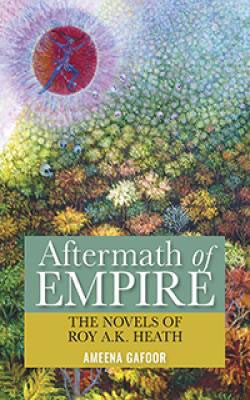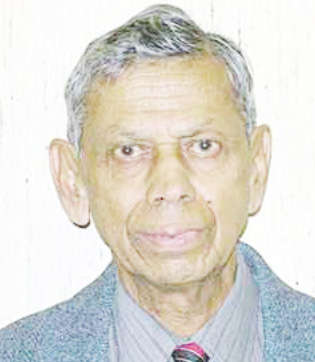Roy Heath’s oeuvre of nine novels proclaim him as one of the finest Anglophone Caribbean novelists, and certainly one of the best from Guyana, so it is something of a surprise that Ameena Gafoor’s Aftermath of Empire: The Novels of Roy A.K. Heath is, so far, the only comprehensive critique of the author’s fiction: it probably speaks to the originality of Gafoor’s critical acumen as well as her patriotic devotion to the future of Guyanese letters. Born in Guyana (formerly British Guiana) Roy Heath (1926 -2008) migrated in 1950 to London, England, where, but for periodic visits to Guyana, he remained for the rest of his life. He studied languages at the University of London and worked throughout his career as a school teacher of French and German; he also qualified as a lawyer but never practised law. His novels are all based on life in Guyana’s capital city of Georgetown from the 1920s to the decade or two immediately after World War Two, when Britain’s Caribbean colonies, including Guyana gained independence from Britain.
 Heath’s first novel A Man Come Home was published in 1979 while his ninth The Ministry of Hope, a brilliant satire on Forbes Burnham’s riotous regime as president, appeared in 1997. Three novels From the Heat of the Day (1979) One Generation (1981) and Genetha (1981), known collectively as the Armstrong trilogy, are next followed by Kwaku or the Man who Could not Keep his Mouth Shut, (1982) Orealla (1984) and The Shadow Bride (1988), while two further novels A Man Come Home (1979) and The Ministry of Hope complete Heath’s oeuvre, except for his second novel The Murderer (1978) which we may take as his best work if its capture of the 1978 fiction prize offered by the British newspaper The Guardian is anything to go by. In addition, Shadows Round the Moon (1990), Heath’s autobiography, is nothing less than a masterpiece of lyrical evocation.
Heath’s first novel A Man Come Home was published in 1979 while his ninth The Ministry of Hope, a brilliant satire on Forbes Burnham’s riotous regime as president, appeared in 1997. Three novels From the Heat of the Day (1979) One Generation (1981) and Genetha (1981), known collectively as the Armstrong trilogy, are next followed by Kwaku or the Man who Could not Keep his Mouth Shut, (1982) Orealla (1984) and The Shadow Bride (1988), while two further novels A Man Come Home (1979) and The Ministry of Hope complete Heath’s oeuvre, except for his second novel The Murderer (1978) which we may take as his best work if its capture of the 1978 fiction prize offered by the British newspaper The Guardian is anything to go by. In addition, Shadows Round the Moon (1990), Heath’s autobiography, is nothing less than a masterpiece of lyrical evocation.
In “A Portrait of an Artist” Chapter One of her book, Gafoor briefly surveys Heath’s biography while acknowledging the contribution of earlier Guyanese novelists such as Edgar Mittelholzer, Wilson Harris and Jan Carew, or poets like AJ Seymour and Martin Carter to Guyanese literature. Chapter Two of The Aftermath of Empire then fills in essential information about Heath’s Armstrong trilogy and the social and cultural history of Guyana as a former British Caribbean colony dominated by ethics based on race, colour and class. After a history of African slavery and Indian indenture, by the twentieth century, a majority of the Guyanese population consisted of Indians descended from indentured labourers, a slightly smaller group of Africans descended from slaves, and much smaller groups of Euro-pean Whites, Chinese, Amerindians, and Portu-guese who are not considered as white because of their indenture background. But Heath’s fiction focuses on yet another small group of mixed African and White ethnicity who, like himself, are known as “coloured”.
After inevitable ethnic and cultural mixing during colonialism an important issue arises about the notion of family in Guyana. As Gafoor writes: “The [coloured] Arm-strong Trilogy is about the Armstrong family, but there is no family, and all evidence points to the illogic of its unity.” Neither is there any settled sense of community as we see from the title of Chapter Three “From the Heat of the Day: In Search of Community.” Indepen-dence brought little change to deep-seated psychological and cultural problems that stifled the natural growth of family, community or nationhood: Guyanese society was too intricately compromised by centuries of ethnic mixing and colonial rule, as suggested by Guyanese historian Elsa Goveia who claims that colonialism had imposed: “a stable and predictable order” on Guyana, but dismantling that order, “left the individual and the society in a void, trapped in postures and mental attitudes that indicate a malignant and crippling interiorization of the old order”.
In an opening paragraph of A Man Come Home, Egbert Foster a 50-year-old artisan living in a modest cottage slightly better than the tenements and range yards of fellow workers, is ironically depicted raising the new Guyana flag on Independence Day, 26th May, 1966, with his dog “sitting under the flag and scratching itself languidly.” As Gafoor writes, one character in A Man Come Home leaves school at the age of 12, “to deliver bread on a carrier bicycle” and another, “to devote his time to a life of sloth” and as they grow older, “gravitate to the vicarious pleasure of rum and sex [and] the fantasy of tall tales of bravado and boasting of imaginary travels to foreign lands.” Gafoor further writes: “Foster is an emasculated colonial whose aspirations are undercut by his own deformed will.” Social confusion and struggle over poverty create loss of community and trickster figures like Fingers who are “metaphors of the degradation endemic in post-colonial societies”.
Most of all though, it is in The Murderer where Galton Flood is overcome by psychosis to murder his wife Gemma and throw her body in the Demerara River that we see the deadliest effect of the failure of freed Guyanese to transcend malign, psychological effects of decolonization. The influence of Galton’s fundamentalist Christian upbringing and the domineering influence of his mother are crippling, and as Gafoor once again argues, he struggles for new freedom and identity in a society “whose collective psychic failure is rooted in the conventional morality of the mother country”. In Gafoor’s view, novels like “A Man Come Home and The Murderer question the existential possibilities of people mired in centuries of crippling cliched relationships that have misshaped the psyche, [and Galton comes to] a grim interpretation of society that argues that the colonial order is deeply embedded and necessitates brutal solutions before independence can acquire meaning and offer viable paradigms of selfhood.” Murder may not be a brutal enough solution to postcolonial problems in The Murderer, but it illustrates the postcolonial dilemma of Guyanese.


